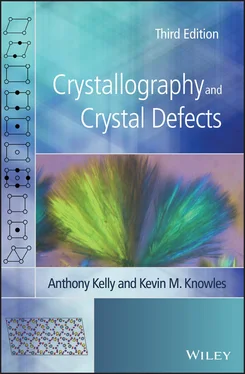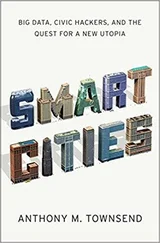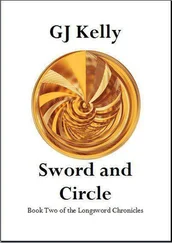1 Cover
2 Preface to the Third Edition
3 Companion Website
4 Part I: Perfect Crystals 1 Lattice Geometry 1.1 The Unit Cell 1.2 Lattice Planes and Directions 1.3 The Weiss Zone Law 1.4 Symmetry Operators 6 1.5 Restrictions on Symmetry Operations 1.6 Possible Combinations of Rotational Symmetries 1.7 Crystal Systems 1.8 Space Lattices (Bravais 12Lattices) Suggestions for Further Reading References 2 Point Groups and Space Groups 2.1 Macroscopic Symmetry Elements 2.2 Orthorhombic System 2.3 Tetragonal System 2.4 Cubic System 2.5 Hexagonal System 2.6 Trigonal System 2.7 Monoclinic System 2.8 Triclinic System 2.9 Special Forms in the Crystal Classes 2.10 Enantiomorphous Crystal Classes 2.11 Laue Groups 2.12 Space Groups 2.13 The 17 Two‐Dimensional Space Groups 2.14 Nomenclature for Point Groups and Space Groups 2.15 Groups, Subgroups, and Supergroups 2.16 An Example of a Three‐Dimensional Space Group 2.17 Frequency of Space Groups in Inorganic Crystals and Minerals 2.18 Magnetic Groups Suggestions for Further Reading References 3 Crystal Structures3.1 Introduction 3.2 Common Metallic Structures 3.3 Related Metallic Structures 3.4 Other Elements and Related Compounds 3.5 Simple MX and MX2 Compounds 3.6 Other Inorganic Compounds 3.7 Interatomic Distances 3.8 Solid Solutions 3.9 Polymers 3.10 Additional Crystal Structures and their Designation Suggestions for Further Reading References 4 Amorphous Materials and Special Types of Crystal–Solid Aggregates4.1 Introduction 4.2 Amorphous Materials 4.3 Liquid Crystals 4.4 Geometry of Polyhedra 4.5 Icosahedral Packing 4.6 Quasicrystals 4.7 Incommensurate Structures 4.8 Foams, Porous Materials, and Cellular Materials Suggestions for Further Reading References 5 Tensors 5.1 Nature of a Tensor 5.2 Transformation of Components of a Vector 5.3 Dummy Suffix Notation 5.4 Transformation of Components of a Second‐Rank Tensor 5.5 Definition of a Tensor of the Second Rank 5.6 Tensor of the Second Rank Referred to Principal Axes 5.7 Limitations Imposed by Crystal Symmetry for Second‐Rank Tensors 5.8 Representation Quadric 5.9 Radius–Normal Property of the Representation Quadric 5.10 Third‐ and Fourth‐Rank Tensors Suggestions for Further Reading References 6 Strain, Stress, Piezoelectricity and Elasticity 6.1 Strain: Introduction 6.2 Infinitesimal Strain 6.3 Stress 6.4 Piezoelectricity 6.5 Elasticity of Crystals 6.6 Elasticity of Cubic Crystals Suggestions for Further Reading References
5 Part II: Imperfect Crystals 7 Glide 7.1 Translation Glide 7.2 Glide Elements 7.3 Independent Slip Systems 7.4 Large Strains of Single Crystals: The Choice of Glide System 7.5 Large Strains: The Change in the Orientation of the Lattice During Glide Suggestions for Further Reading References 8 Dislocations 8.1 Introduction 8.2 Dislocation Motion 8.3 The Force on a Dislocation 8.4 The Distortion in a Dislocated Crystal 8.5 Atom Positions Close to a Dislocation 8.6 The Interaction of Dislocations with One Another Problems Suggestions for Further Reading References 9 Dislocations in Crystals 9.1 The Strain Energy of a Dislocation 9.2 Stacking Faults and Partial Dislocations 9.3 Dislocations in C.C.P. Metals 9.4 Dislocations in the Rock Salt Structure 9.5 Dislocations in Hexagonal Metals 9.6 Dislocations in B.C.C. Crystals 9.7 Dislocations in Some Covalent Solids 9.8 Dislocations in Low Symmetry Crystal Structures 9.9 Dislocations in Other Crystal Structures Suggestions for Further Reading References 10 Point Defects 10.1 Introduction 10.2 Point Defects in Ionic Crystals 10.3 Point Defect Aggregates 10.4 Point Defect Configurations 10.5 Experiments on Point Defects in Equilibrium 10.6 Experiments on Quenched Metals 10.7 Radiation Damage 10.8 Anelasticity and Point Defect Symmetry Suggestions for Further Reading References 11 Twinning 11.1 Introduction 11.2 Description of Deformation Twinning 11.3 Examples of Twin Structures 11.4 Twinning Elements 11.5 The Morphology of Deformation Twinning 11.6 Friedel's Classification of (Growth) Twinning 11.7 Atomistic Modelling of Twin Boundaries Suggestions for Further Reading References 12 Martensitic Transformations12.1 Introduction 12.2 General Crystallographic Features 12.3 Transformation in Cobalt 12.4 Transformation in Zirconium 12.5 Transformation in Indium–Thallium Alloys 12.6 Transformations in Steels 12.7 Transformations in Copper Alloys 12.8 Transformations in Ni–Ti‐Based Alloys 12.9 Magnetic Shape Memory Alloys 12.10 Transformations in Non‐metals 12.11 Crystallographic Aspects of Nucleation and Growth 12.12 The Shape Memory Effect and Superelasticity 12.13 Modern Theories of Martensitic Transformations Suggestions for Further Reading References 13 Grain Boundaries13.1 The Structure of Surfaces and Surface Free Energy 13.2 Structure and Energy of Grain Boundaries 13.3 Equivalent Geometrical Descriptions of High‐Angle Grain Boundaries 13.4 Interface Junctions 13.5 The Shapes of Crystals and Grains Suggestions for Further Reading References 14 Interphase Boundaries 14.1 Boundaries Between Different Phases 14.2 Interphase Boundaries Between C.C.P. and B.C.C. Phases 14.3 Strained Layer Epitaxy of Semiconductors Suggestions for Further Reading References 15 Texture15.1 Texture 15.2 Euler Angles 15.3 Microtexture Suggestions for Further Reading References
6 Appendix 1: Appendix 1 Crystallographic Calculations A1.1. Vector Algebra A1.2. The Reciprocal Lattice A1.3. Matrices A1.4. Rotation Matrices and Unit Quaternions References
7 Appendix 2: Appendix 2 The Stereographic ProjectionA2.1 Principles A2.2 Constructions A2.3 Constructions with the Wulff Net A2.4 Proof of the Properties of the Stereographic Projection References
8 Appendix 3: Appendix 3 Interplanar Spacings and Interplanar AnglesA3.1. Interplanar Spacings A3.2. Interplanar Angles
9 Appendix 4: Appendix 4 Transformation of Indices Following a Change of Unit Cell A4.1. Change of Indices of Directions A4.2. Change of Indices of Planes A4.3. Example 1: Interchange of Hexagonal and Orthorhombic Indices for Hexagonal Crystals A4.4. Example 2: Interchange of Rhombohedral and Hexagonal Indices
10 Appendix 5: Appendix 5 Slip Systems in C.C.P. and B.C.C. Crystals A5.1. Independent Glide Systems in C.C.P. Metals A5.2. Diehl's Rule and the OILS Rule A5.3. Proof of Diehl's Rule and the OILS Rule References
11 Appendix 6: Appendix 6 Homogeneous Strain A6.1 Simple Extension A6.2 Simple Shear A6.3 Pure Shear A6.4 The Relationship Between Pure Shear and Simple Shear
12 Appendix 7: Appendix 7 Crystal Structure DataA7.1 Crystal Structures of the Elements, Interatomic Distances and Six‐Fold Coordination‐Number Ionic Radii A7.2 Crystals with the Sodium Chloride Structure A7.3 Crystals with the Caesium Chloride Structure A7.4 Crystals with the Sphalerite Structure A7.5 Crystals with the Wurtzite Structure A7.6 Crystals with the Nickel Arsenide Structure A7.7 Crystals with the Fluorite Structure A7.8 Crystals with the Rutile Structure
13 Appendix 8: Appendix 8 Further ResourcesA8.1 Useful Web Sites A8.2 Educational and Information Resources A8.3 Computer Software Packages
14 Brief Solutions to Selected Problems 1Chapter 1 Chapter 2 Chapter 3 Chapter 4 Chapter 5 Chapter 6 Chapter 7 Chapter 8 Chapter 9 Chapter 10 Chapter 11 Chapter 12 Chapter 13 Chapter 14 Chapter 15
15 Index
16 End User License Agreement
1 Chapter 1 Table 1.1 Solutions of Eq. (1.22) Table 1.2 Permissible combinations of rotation axes in crystals Table 1.3 The crystal systems
2 Chapter 2 Table 2.1 Special forms in the crystal classes Table 2.2 Laue groups Table 2.3 Screw axes in crystals Table 2.4 Two‐dimensional lattices, point groups and space groups
3 Chapter 3 Table 3.1 Axial ratios at room temperature of some metals with a h.c.p. cryst... Table 3.2 Cell dimensions of As, Sb and Bi.Table 3.3 Axial ratios at room temperature of some materials with the wurtzit...Table 3.4 Axial ratios at room temperature of some materials with the nickel ...Table 3.5 Some examples of superlattice types.Table 3.6 Crystal structures of some common polymers.
Читать дальше












